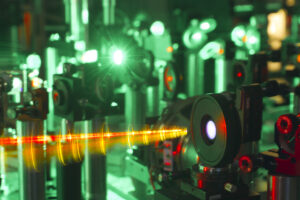Leadership
- Prof. Dr. Uwe Morgner, Leibniz University Hannover, PhoenixD
- Prof. Dr. Georgeta Salvan, University of Technology Chemnitz
- Prof. Dr. Mario Agio, University of Siegen
Optics and photonics is a very broad and rapidly expanding research topic. Traditionally, the field of research and application of optical phenomena is assigned to physics and the field of optical apparatus construction to mechanical engineering. However, in the 21st century, in the light of modern optics research, this separation is becoming increasingly less adequate. Today, optics and photonics is a highly interdisciplinary field and is increasingly developing into an independent research discipline. For the development, construction and use of ultrashort pulse lasers, for example, knowledge of non-linear optics is no longer sufficient. The use of these physical effects poses equally high scientific challenges to material development, laser development and production technology. The situation is similar with regard to the topic of optical integration.
 Silicon photonics is on a path that is not only comparable in some respects to the development of microelectronics in the 20th century, but it also uses the same production processes. In the visible spectral range, new types of functional materials, especially polymers, are today increasingly replacing glass as the traditional material of optics. Furthermore, the polarization of light can be exploited for characterization as well as application purposes. All these lines of development in modern optics open up new areas of application largely and only partially replace traditional optics applications. Lasers, in particular, have become a universal tool in the natural sciences, life sciences and technology and are nevertheless still the subject of active physical research in many areas.
Silicon photonics is on a path that is not only comparable in some respects to the development of microelectronics in the 20th century, but it also uses the same production processes. In the visible spectral range, new types of functional materials, especially polymers, are today increasingly replacing glass as the traditional material of optics. Furthermore, the polarization of light can be exploited for characterization as well as application purposes. All these lines of development in modern optics open up new areas of application largely and only partially replace traditional optics applications. Lasers, in particular, have become a universal tool in the natural sciences, life sciences and technology and are nevertheless still the subject of active physical research in many areas.
As the acquired data in the field of optics is highly heterogeneous and has overlap with many other disciplines like chemistry or engineering there is the need for flexible and transdisciplinary meta data standards to fulfil the FAIR principles. Because the data in the domain is partially obtained by home build devices, which are topic of current research, we welcome tools and pipelines, which help to document the processing steps and simplify the exchange between individual researchers. The definition of standardized interfaces and guidelines for data exchange could decrease the redundant work of data parsing in the data pipeline. In many fields, there exist no standardized measurement procedures or measurement systems. Therefore, an open meta data standard with a generic hierarchical structure and the option of proprietary data fields is required.
Use cases
- OptPho01 Prof. Dr. Mario Agio
- OptPho02 Prof. Dr. Uwe Morgner
- OptPho03 Prof. Dr. Georgeta Salvan, Dr. Andreas Hertwig, Dr. Eva Bittrich
- OptPho04 Prof. Dr. Ralf Bergmann
- OptPho05 Prof. Dr. Martin Wegener
- OptPho06 Dr. Steffen Brinckmann
- OptPho07 Dr. Stefan Winter
previous domain (Atoms and Molecules) | domain list | next domain (Physics of Plasma)